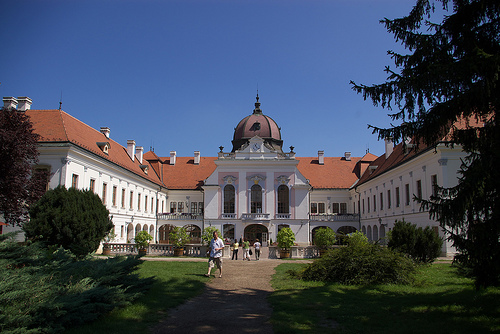

Location: 22 mi (35 km) northeast of Budapest Map
Construction: 1733 under supervision of András Mayerhoffer
Royal palace of Gödöllő
Tel. (028) 41 01 24
Open: Apr- Oct 10am-6pm daily
Nov- Mar 10am- 5pm Tue- Sun
Summer Theatre Festival (June- July)
Summer Music Festival (July- Aug)
Gödöllő Town Museum
Szabaszag ter 5
Tel. (028) 42 20 02
Open: 10am- 6pm Tue- Sun
Palace in Gödöllő is located 22 mi (35 km) northeast of Budapest in Hungary. The construction began in 1733 under supervision of András Mayerhoffer.
Location
Gödöllő is located 30 km northeast of
Budapest, in the valley of the Rákos stream in the Gödöllő hills.
Approach
A transport hub, main road 3 and the M3 motorway
cross the city, which is branched off from here by the M31 motorway
to the eastern section of the M0 ring road. In addition, there are
inferior roads leading to Vác, Pécel and Jászberény from the
settlement.
It is also affected by the Budapest-Hatvan
railway line, and the terminus of the BKV H8 HÉV service is also
located here. Gödöllő has 9 local bus services and several
long-distance bus services pass through it.
History
Gödöllő was first mentioned in 1349 in a donation letter from Louis
I. The name of the settlement occurs in the forms Gudulleu,
Gudullur, Gödöle, Gedellő in the early diplomas, in 1868 it
officially won the name Gödöllő. It was completely destroyed during
the Turkish occupation and later repopulated.
Ferenc Hamvay
was the first landlord to live in Gödöllő in his mansion built in
the center in 1662, which today houses the City Museum and the City
Cinema.
In the 18th century, the landlord, the labanc
Habsburg official, made the settlement the center of the estates of
Antal Grassalkovich, who could not be called Hungarian-friendly. He
built the castle using the Reformed church. Much of the monuments of
today’s city date back to the time of Grassalkovich. In 1763 it
became a market town. Due to its fairs and geographical location, it
was the center of the area, a transit area between the Great Plain
and the Highlands. In 1841, the Grassalkovich family became extinct,
so the Viczay family inherited the estates, after a short time we
find the Sina family as the landlord of the settlement, and
eventually became the property of a Belgian bank.
During the
War of Independence in 1848, the castle was the residence of
Windisch-Grätz, and after the battle of Isaszeg it was the
headquarters of Lajos Kossuth. Kossuth formulated the Declaration of
Independence here.
After the compromise, the Hungarian state
repurchased the estate from the owner's Belgian bank and offered it
as a coronation gift for permanent use to the current ruling family,
which was then Queen Franz Joseph I and Queen Elizabeth ("Sisi").
The castle became one of the royal family's favorite holiday
destinations, they spent several summers here, and Queen Elizabeth
was said to have been a favorite holiday resort.
The
prominent royal attention ensured rapid development. The railway
connection was established, and in 1884 it became a large village.
Since 1911, Gödöllő has also been connected to Budapest by the HÉV
line. What is interesting about this line is that since then there
has been a reverse traffic schedule, ie the trains run on the left
side in the direction of travel. In the same year, a cemetery from
the time of the Hungarian conquest was discovered on the property of
Secretary of State László Kaffka.
At the end of the First
World War IV. King Charles learned here of the collapse of the
Austro-Hungarian Monarchy. In 1919, Aurél Stromfeld, Chief of Staff
of the Red Army of the Soviet Republic, set up his headquarters in
the castle. Between the two world wars, the settlement was the
residence of Miklós Horthy. In 1933, the city hosted the world
meeting of boy scouts, the Jembo.
During World War II, the
building of today's St. Stephen's University was hit by several
bombings, and operated as a military hospital towards the end of the
war. After the city was occupied by Soviet troops on December 12,
1944, a 30,000-strong Soviet prison camp was established in and
around the building in January 1945, where an estimated 50,000
Hungarian and German soldiers and civilians were imprisoned by the
time the camp closed in March. In 2011, a German war grave was
unearthed during the renovation work on Elizabeth Park.
After
World War II, it developed into an agricultural center. Part of the
Grassalkovich Castle became a Soviet barracks, and the Social Home
of the Metropolitan Council was moved to another part. In 1950, the
University of Agricultural Sciences (later merged with other
universities and colleges as Szent István University) and the Ganz
Electricity Meter Factory were established here. As a result of
industrialization and the creation of new jobs, the population
jumped by the 1960s. It was then that the first housing estates were
built. Máriabesnyő was added in 1965, making Gödöllő a town since
January 1, 1966. After the declaration of the city, the development
of the settlement into a socialist city accelerated. In the late
1970s, the blocks of buildings that defined the image of today’s
downtown were built.
In 1989, Ferencné Cservenka - the first
secretary of the Pest County Party Committee, the decision-maker
affecting the city - was the first Member of Parliament to be
recalled from office by the still-emerging opposition. Collection of
signatures began in the city, and finally in early April 1989, the
deputy resigned.
During the 2011 Hungarian EU Presidency,
most of the informal ministerial meetings were held in the Royal
Castle of Gödöllő.